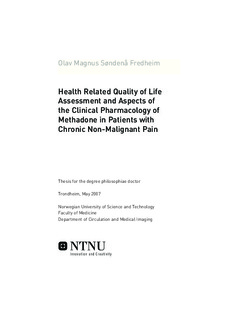| dc.contributor.author | Fredheim, Olav Magnus Søndenå | nb_NO |
| dc.date.accessioned | 2014-12-19T14:23:21Z | |
| dc.date.available | 2014-12-19T14:23:21Z | |
| dc.date.created | 2008-02-14 | nb_NO |
| dc.date.issued | 2007 | nb_NO |
| dc.identifier | 123463 | nb_NO |
| dc.identifier.isbn | 978-82-471-2114-6 | nb_NO |
| dc.identifier.uri | http://hdl.handle.net/11250/264619 | |
| dc.description.abstract | Introduction
The patients with the most severe and complex chronic non-malignant pain (CNMP) conditions are admitted to multidisciplinary pain centres. A poor health related quality of life (HRQoL) has been documented in these patients but their HRQoL scores have to a very limited degree been compared to other patient groups. Such comparisons require the application of the same HRQoL instruments in different populations. While nonpharmacological treatment is preferred in this patient group, treatment with strong opioids is an option for some patients. After start of opioid therapy about half the patients experience an unacceptable balance between side effects and pain relief. According to research in cancer pain, a switch to methadone may improve pain control in these patients. However, there are several areas of uncertainty related to this switch in CNMP patients. It has not been evaluated in prospective studies with long-term follow up and both increased QTc time (QT time adjusted for heart rate) and autoinduction of methadone metabolism during long term treatment have been indicated in other patient populations.
Research questions
HRQoL assessment methodology in CNMP patients:
I. Is the EORTC QLQ-C30 a valid alternative to the SF-36 for assessment of HRQoL in CNMP patients?
Comparison of HRQoL scores between patient groups:
II. How is the HRQoL of CNMP patients admitted to multidisciplinary pain centre treatment compared to the HRQoL of palliative cancer patients?
Opioid switching from morphine to methadone in CNMP patients with an unacceptable balance between pain control and side effects during morphine therapy:
III. What are the effects on pain control, HRQoL, cognitive functioning and patient preference?
IV. What is the effect on QTc time?
V. Are methadone serum concentrations stable during long term treatment and are there interindividual differences in opioid metabolism?
Methods
HRQoL data were collected from 288 CNMP patients admitted to multidisciplinary pain treatment. These data were used for psychometric validation of the EORTC QLQ-C30 HRQoL questionnaire and for comparison of HRQoL with palliative cancer patients. Twelve patients with unacceptable balance between pain control and side effects during morphine treatment for CNMP switched to methadone. Pain, HRQoL, cognitive functioning, opioid serum concentrations and QTc were evaluated at baseline and one, two, six and 13 weeks and nine months later.
Results
Internal consistency was below 0.70 for five of nine EORTC QLQ-C30 multi-item scales. Large floor or ceiling effects were seen for several scales. These weaknesses do not disrupt the picture of overall acceptable psychometric properties in this population.
Compared to palliative cancer patients, patients with CNMP reported poorer global quality of life and cognitive functioning and more pain, sleep disturbances and financial difficulties as well as equally poor physical, social and emotional functioning and equally high levels of diarrhoea, dyspnoea and fatigue.
Seven patients preferred long-term (> nine months) treatment with methadone and reported reduced pain and improved functioning while cognition was not improved. On the other hand one patient experienced sedation requiring naloxone and four patients were switched back to morphine due to poor pain control, drowsiness or sweating. Mean increase in QTc was 0.020 seconds. Serum concentrations of methadone and its metabolite EDDP were stable from the end of dose titration and during the nine months.
Conclusions
-The EORTC QLQ-C30 is a valid alternative to the SF-36 for HRQoL assessment in CNMP patients.
-CNMP patients admitted to multidisciplinary pain centres report as poor HRQoL as palliative cancer patients.
-Opioid switching to methadone causes improved pain control and HRQoL in some patients but is not beneficial to all patients and poses a risk of serious sedation. | nb_NO |
| dc.language | eng | nb_NO |
| dc.publisher | Det medisinske fakultet | nb_NO |
| dc.relation.ispartofseries | Doktoravhandlinger ved NTNU, 1503-8181; 2007:96 | nb_NO |
| dc.relation.haspart | Fredheim, Olav Magnus Søndenå; Borchgrevink, Petter C; Saltnes, Turi; Kaasa, Stein. Validation and Comparison of the Health-Related Quality-of-Life Instruments EORTC QLQ-C30 and SF-36 in Assessment of Patients with Chronic Nonmalignant Pain. Journal of Pain and Symptom Management. 34(6): 657-665, 2007. | nb_NO |
| dc.relation.haspart | Fredheim, Olav Magnus Søndenå; Kaasa, Stein; Fayers, Peter; Jordhøy, Marit S; Borchgrevink, Petter C. Chronic non-malignant pain patients report as poor health-related quality of life as palliative cancer patients. Acta Anaesthesiologica Scandinavica. 52(1): 143-148, 2008. | nb_NO |
| dc.relation.haspart | Fredheim, Olav Magnus Søndenå; Kaasa, Stein; Dale, Ola; Klepstad, Pål; Landrø, Nils Inge; Borchgrevink, Petter C. Opioid switching from oral slow release morphine to oral methadone may improve pain control in chronic non-malignant pain: a nine-month follow-up study. Palliative Medicine. 20(1): 35-41, 2006. | nb_NO |
| dc.relation.haspart | Fredheim, Olav Magnus Søndenå; Borchgrevink, Petter C; Klepstad, Pål; Kaasa, Stein; Dale, Ola. Long term methadone for chronic pain: A pilot study of pharmacokinetic aspects. European Journal of Pain. 11(6): 599-604, 2007. | nb_NO |
| dc.relation.haspart | Fredheim, Olav Magnus Søndenå; Borchgrevink, Petter C; Hegrenæs, Lars; Kaasa, Stein; Dale, Ola; Klepstad, Pål. Opioid Switching from Morphine to Methadone Causes a Minor But Not Clinically Significant Increase in QTc Time: A Prospective 9-Month Follow-Up Study. Journal of Pain and Symptom Management. 32(2): 180-185, 2006. | nb_NO |
| dc.title | Health related quality of life assessment and aspects of the clinical pharmacology of methadone in patiens with chronic non-malignant pain | nb_NO |
| dc.type | Doctoral thesis | nb_NO |
| dc.contributor.department | Norges teknisk-naturvitenskapelige universitet, Det medisinske fakultet, Institutt for sirkulasjon og bildediagnostikk | nb_NO |
| dc.description.degree | PhD i klinisk medisin | nb_NO |
